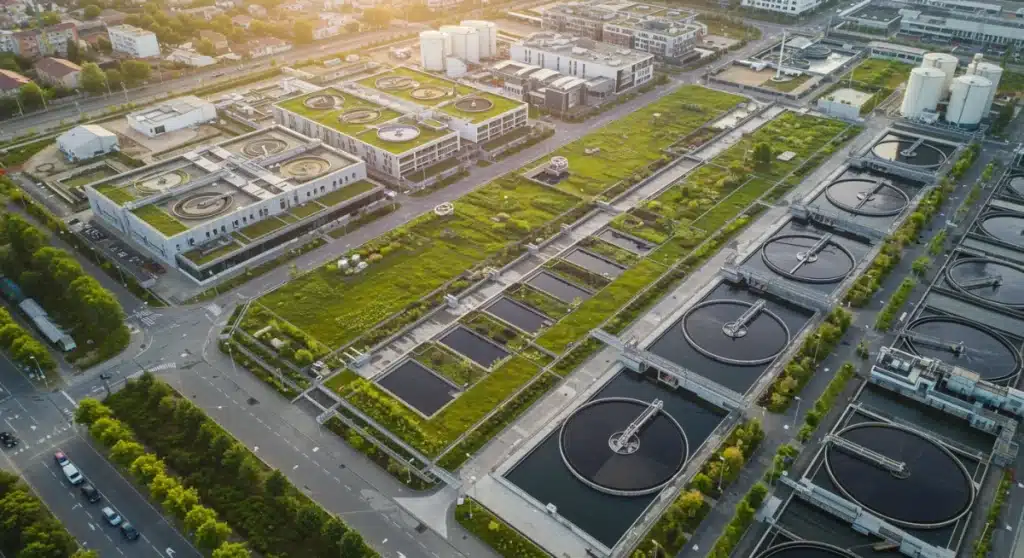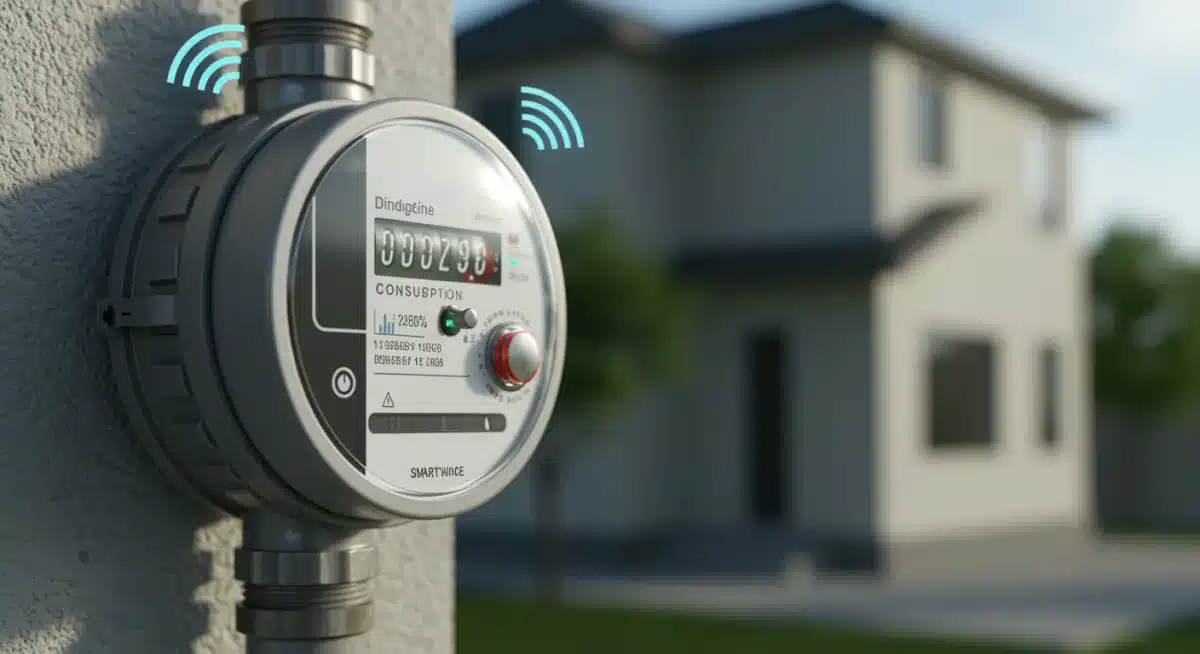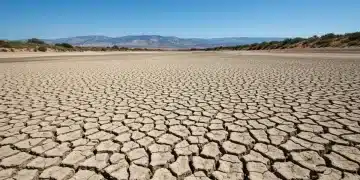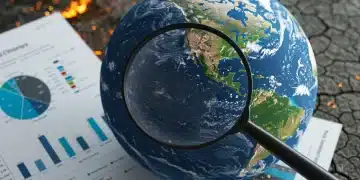Sustainable Water Management: Green Tech to Save U.S. Water

As the urgency for water conservation intensifies, U.S. municipalities are making significant strides in adopting innovative strategies. The focus is squarely on sustainable water management, with a bold target: conserving 10% more water by 2025 through the widespread implementation of green technology.
The Imperative for Water Conservation in U.S. Cities
Water scarcity is no longer a distant threat but a present reality for many regions across the United States. Growing populations, aging infrastructure, and changing climate patterns are placing unprecedented strain on municipal water supplies. This escalating pressure necessitates a proactive and technologically driven approach to ensure water security for future generations.
Municipalities are recognizing that traditional water management practices are insufficient to meet current and future demands. The need to reduce water loss, optimize usage, and explore alternative sources has become a top priority. This shift is driving investments in advanced solutions that promise both environmental benefits and economic efficiencies.
Addressing Aging Infrastructure
- Leak Detection Systems: Advanced sensor networks and acoustic monitoring are being deployed to pinpoint and repair leaks in aging pipe networks, preventing significant water loss.
- Smart Metering: Digital meters provide real-time consumption data, empowering consumers and utilities to identify inefficiencies and encourage conservation.
- Pipe Replacement Programs: Long-term strategies involve replacing old, brittle pipes with more durable materials, reducing the likelihood of future leaks and ruptures.
The financial implications of water loss through aging infrastructure are substantial. Billions of gallons are lost annually, representing not only a waste of a vital resource but also a significant economic drain on municipalities. Modernizing these systems is a crucial step towards achieving water conservation goals.
Green Technology as a Game Changer
Green technology is emerging as a cornerstone of modern sustainable water management. These innovations span a wide range of applications, from intelligent irrigation systems to advanced wastewater treatment, all designed to minimize water footprint and maximize efficiency. The integration of these technologies is not merely incremental but represents a transformative shift in how cities manage their most precious resource.
Recent developments highlight the accelerated adoption of these solutions. For example, several major cities have recently announced pilot programs leveraging AI-powered systems for predictive maintenance in water networks, aiming to prevent issues before they occur. These initiatives underscore a growing commitment to proactive water stewardship.
Innovations in Water Treatment and Reuse
- Membrane Bioreactors (MBRs): These advanced systems combine biological treatment with membrane filtration, producing high-quality effluent suitable for reuse in various applications.
- Advanced Oxidation Processes (AOPs): AOPs effectively remove persistent organic pollutants and trace contaminants, making treated wastewater safer for indirect potable reuse.
- Decentralized Treatment Systems: Smaller, localized treatment plants reduce the need for extensive pipe networks and allow for more efficient water recycling within specific communities or districts.
The focus on water reuse is particularly impactful. By treating and repurposing wastewater, municipalities can significantly reduce their reliance on freshwater sources, easing the burden on natural ecosystems and improving overall water resilience. This circular approach to water management is a key component of the 2025 conservation target.
Smart Water Grids and Data-Driven Conservation
The concept of a ‘smart water grid’ is rapidly gaining traction, integrating digital technology to monitor, control, and optimize water distribution and usage. These grids leverage sensors, data analytics, and automation to provide unprecedented visibility into water systems, enabling more informed decision-making and rapid response to issues. The goal is to move from reactive maintenance to predictive management.
Real-time data collection is revolutionizing how municipalities understand their water consumption patterns. By analyzing this data, utilities can identify peak usage times, detect anomalies indicative of leaks, and tailor conservation programs more effectively to specific neighborhoods or user groups. This precision allows for targeted interventions that yield greater conservation results.

Components of a Smart Water Grid
- Sensor Networks: Thousands of sensors deployed throughout the water infrastructure collect data on flow rates, pressure, temperature, and water quality.
- Data Analytics Platforms: Centralized systems process vast amounts of sensor data, identifying trends, predicting failures, and flagging potential issues.
- Automated Control Systems: These systems can automatically adjust valve settings, pump speeds, and irrigation schedules based on real-time data and demand forecasts.
The predictive capabilities of smart water grids are transforming asset management. Instead of waiting for a pipe to burst, utilities can now anticipate potential failures and schedule maintenance proactively, minimizing service disruptions and preventing costly water losses. This proactive stance is essential for achieving ambitious conservation targets.
Policy and Public Engagement for Sustainable Water Management
Technological advancements alone are not enough to achieve the 10% conservation goal; supportive policies and robust public engagement are equally critical. Municipalities are implementing a combination of regulations, incentives, and educational campaigns to foster a culture of water conservation among residents and businesses. These efforts aim to complement technological solutions by influencing behavior.
Recent policy updates include tiered water pricing structures that encourage lower consumption, as well as rebates for installing water-efficient appliances and landscaping. Public awareness campaigns, often leveraging social media and community events, are educating citizens about their role in preserving water resources and the benefits of adopting water-saving habits.
Effective Public Engagement Strategies
- Educational Workshops: Offering free workshops on drought-resistant landscaping, efficient irrigation, and indoor water-saving tips.
- Community Challenges: Organizing neighborhood-level water conservation challenges with public recognition or small incentives for participation.
- Digital Communication: Utilizing utility websites, social media, and newsletters to share conservation tips, local water news, and program updates.
The success of these initiatives hinges on clear communication and active participation. When residents understand the ‘why’ behind conservation efforts and see the tangible benefits, they are more likely to embrace and sustain water-saving behaviors. This collective effort is indispensable for reaching the ambitious 2025 target.
Case Studies: U.S. Municipalities Leading the Way
Across the U.S., various municipalities are showcasing remarkable progress in sustainable water management through green tech integration. These success stories provide valuable blueprints for other cities striving to meet or exceed the 10% conservation goal. Their experiences demonstrate that strategic investment and innovative thinking can yield significant results.
For instance, a city in the Southwest, historically prone to droughts, recently reported a 12% reduction in municipal water use over two years, primarily through a combination of smart irrigation systems for public spaces and a comprehensive leak detection program. Another example from the Pacific Northwest involved integrating rainwater harvesting systems into new urban developments, reducing stormwater runoff and supplementing non-potable water needs.
Notable Municipal Achievements
- Los Angeles, CA: Extensive adoption of recycled water for irrigation and industrial use, coupled with aggressive turf replacement programs.
- San Antonio, TX: Implementation of advanced aquifer storage and recovery projects, alongside robust conservation incentives for residents.
- Atlanta, GA: Focus on green infrastructure to manage stormwater, reducing strain on potable water systems and improving water quality.
These examples underscore the diverse approaches being taken, tailored to regional needs and challenges. What unites them is a commitment to leveraging green technology and data-driven strategies for effective water conservation. Their achievements offer hope and practical guidance for the broader national effort.
Overcoming Challenges and Future Outlook
While significant progress is being made, the path to widespread sustainable water management is not without its challenges. Funding for large-scale infrastructure upgrades, public acceptance of new technologies, and the complexity of integrating diverse systems are all hurdles that municipalities must navigate. However, the outlook remains optimistic, driven by continued innovation and a growing recognition of water’s critical value.
Overcoming financial barriers often involves securing federal grants, establishing public-private partnerships, and exploring innovative financing mechanisms such as green bonds. Educating the public about the safety and benefits of advanced water treatment and reuse technologies is also crucial for gaining social license and fostering trust. The collaborative efforts between government, industry, and academia are accelerating the development and deployment of solutions.
Key Challenges and Solutions
- Funding: Leveraging federal infrastructure bills, state grants, and private investment to finance high-cost green tech projects.
- Public Acceptance: Transparent communication and educational campaigns to build trust in recycled water and smart technologies.
- System Integration: Developing interoperable platforms and standards to seamlessly integrate various smart water technologies.
Looking ahead, the next few years will likely see even more sophisticated green technologies emerge, including AI-powered water quality monitoring and advanced desalination techniques becoming more cost-effective. The target of conserving 10% more water by 2025 is ambitious but appears increasingly achievable, positioning the U.S. at the forefront of global water stewardship. Continued investment in research and development will be essential to sustain this momentum and address future water security challenges effectively.
| Key Aspect | Brief Description |
|---|---|
| Conservation Target | U.S. municipalities aim to conserve 10% more water by 2025. |
| Green Technology Role | Key driver for achieving targets through smart grids, leak detection, and water reuse. |
| Smart Water Grids | Utilize data and sensors for real-time monitoring and optimized water distribution. |
| Policy & Engagement | Supportive regulations and public education are crucial for behavioral change. |
Frequently Asked Questions About Water Conservation
Sustainable water management involves using water resources in a way that meets current needs without compromising the ability of future generations to meet their own needs, focusing on efficiency, reuse, and protection of water sources.
Green technology aids water conservation through innovations like smart irrigation, advanced leak detection, efficient wastewater treatment for reuse, and intelligent monitoring systems that reduce waste and optimize usage.
The U.S. municipal target is to conserve 10% more water by 2025. This ambitious goal drives the adoption of new technologies and policy changes across cities nationwide.
Smart water grids integrate digital and communication technologies into water infrastructure for real-time monitoring, control, and optimization of water distribution, enhancing efficiency and reducing losses significantly.
Individuals can contribute by fixing leaks, installing water-efficient appliances, practicing drought-resistant landscaping, taking shorter showers, and staying informed about local conservation programs and policies.
What Happens Next
The momentum behind sustainable water management in U.S. municipalities is expected to accelerate. We anticipate continued federal and state funding for green infrastructure projects, further incentivizing cities to adopt advanced water-saving technologies. The focus will likely shift towards greater integration of AI and machine learning for predictive analytics in water systems, making conservation efforts even more precise and effective. Public-private partnerships are also set to become more prevalent, bringing innovative solutions to market faster. Monitoring the progress toward the 2025 conservation goal will be critical, with early indicators suggesting many municipalities are on track to meet or even exceed the target.





